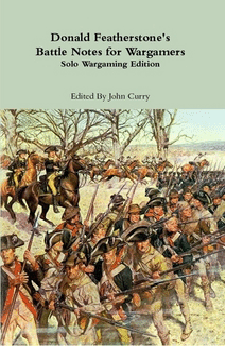The History of Wargaming Project
The project aims to make the largest possible collection of wargaming books and rules available to the modern reader. Ranging from second editions of wargaming classics, to professional wargaming rules used by the military and innovations in current wargaming.

|
|
Recreational Wargaming...Solo Wargaming

|
Donald Featherstone's Battle Notes for Wargamers Solo Wargaming Edition
27 March 2011
by Donald Featherstone Edited by John Curry |
|---|---|
|
Donald Featherstone has revised his classic book on various battles. The
book describes 15 key battles with the solo wargamer in mind. Including
the enemy forces, terrain, enemy orders and other factors leading to
surprise.
Chapters include: 1. The Battle of Pharsalus 2. The Battle of Poitiers 3. The Battle of Barnet 4. The Battle of Cheriton 5. The Battle of Wynendael 6. The Battle of Prestonpans 7. The Battle of Guilford Courthouse 8. The Battle of Maida 9. The Battle of Aliwal 10. The Battle of Wilson's Creek 11. The Battle of the Little Big Horn 12. The Battle of Modder River 13. The ANZAC Landing at Gallipoli 14. The Raid on St Nazaire 15. The Attack on Pork Chop Hill.
|
|
|
| Review of Battle Notes for Wargamers
As I owned the original, I was a little curious about the new version. Well, what can I say. The material for each battle has been reordered to help the solo player. So I had a go. I choose the battle of Pharsalus and I assembled my army. This was Airfix Romans, which shows my age. I laid out the terrain and the armies. I gave my orders and then read the orders for the other side and the rule suggestions for that particular battle. The battle was entertaining and strangely enough, I was victorious as Caesar. I then laid out my victorious column for my triumphant march into Roman (thus finding a use for the Airfix four horse chariot included in each box). The game was interesting and it was made more fun having ‘someone else’ give the other side some initial orders. But the book is not a complete solo guide to wargaming. So after the start, you need to use your usual solo command system to give orders to the ‘other side’. Perhaps it should have been called the scenario book for solo wargamers. The book is worth getting, and it is cheap. David Smith, UK. January 2011 |